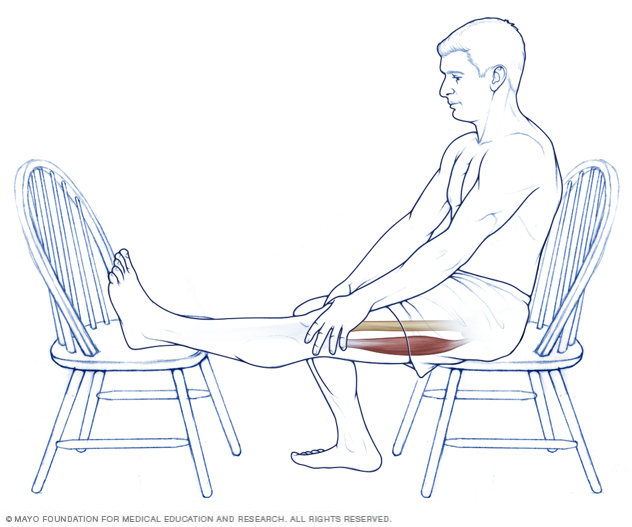A hamstring injury occurs when you strain or pull one of your hamstring muscles — the group of three muscles that run along the back of your thigh.
You may be more likely to get a hamstring injury if you play soccer, basketball, football, tennis or a similar sport that involves sprinting with sudden stops and starts. Hamstring injury can occur in runners and in dancers as well.
Self-care measures such as rest, ice and over-the-counter pain medications are often all you need to relieve the pain and swelling associated with a hamstring injury. Rarely, surgery may be needed to repair a hamstring muscle or tendon.
Symptoms
A hamstring injury typically causes a sudden, sharp pain in the back of your thigh. You might also feel a "popping" or tearing sensation. Swelling and tenderness usually develop within a few hours. You may also experience bruising or discoloration along the back of your leg, as well as muscle weakness or an inability to put weight on your injured leg.
When to see a doctor
Mild hamstring strains can be treated at home. But you should see a doctor if you can't bear any weight on your injured leg or if you can't walk more than four steps without significant pain.
Causes
The hamstring muscles are a group of three muscles that run along the back of your thigh from your hip to just below your knee. These muscles make it possible to extend your leg straight behind your body and to bend your knee. When any one of these muscles stretches beyond its limit during physical activity, injury can result.
Risk factors
Hamstring injury risk factors include:
- Sports participation. Sports that require sprinting or running, or other activities such as dancing that might require extreme stretching, make a hamstring injury more likely.
- Prior hamstring injury. After you've had one hamstring injury, you're more likely to have another one, especially if you try to resume all your activities at pre-injury levels of intensity before your muscles have time to heal and rebuild strength.
- Poor flexibility. If you have poor flexibility, your muscles may not be able to bear the full force of the action required during certain activities.
- Muscle imbalance. Although not all experts agree, some suggest that a muscle imbalance may lead to hamstring injury. When the muscles along the front of your thigh — the quadriceps — become stronger and more developed than your hamstring muscles, you may be more likely to injure your hamstring muscles.
Complications
Returning to strenuous activities before your hamstring muscles are completely healed might cause an injury recurrence.
Prevention
As part of an overall physical conditioning program, regular stretching and strengthening exercises can help minimize your risk of hamstring injury. Try to be in shape to play your sport; don't play your sport to get in shape.
If you have a physically demanding occupation, regular conditioning can help prevent injuries. Ask your doctor about appropriate conditioning exercises.
Diagnosis
During the physical exam, your doctor will check for swelling and points of tenderness along the back of your thigh. The location and intensity of your pain can help determine the extent and nature of the damage.
Your doctor might also move your injured leg into a variety of positions to help pinpoint which muscle has been injured and if you also have any ligament or tendon damage.
Imaging tests
In severe hamstring injuries, the muscle can tear or even detach from where it's connected to the pelvis or shinbone. Sometimes, a small piece of bone is pulled away (avulsion fracture) from the main bone when this detachment occurs. X-rays can check for avulsion fractures, while ultrasound and MRIs can visualize tears in your muscles and tendons.
Treatment
The initial goal of treatment is to reduce pain and swelling. To accomplish this, your doctor may recommend that you do the following:
- Take a break from strenuous activities to allow the injury to heal.
- Use a cane or crutches to avoiding putting your full weight on your injured leg.
- Apply ice packs several times a day to relieve pain and reduce swelling.
- Wrap the injured area with a compression bandage or wear compression shorts to minimize swelling.
- Rest with your leg elevated above the level of your heart, if possible, to improve drainage and minimize swelling.
- Take an over-the-counter pain medication, such as ibuprofen (Advil, Motrin IB, others) or acetaminophen (Tylenol, others), to reduce pain and inflammation.
Physical therapy
After the initial pain and swelling of a hamstring injury subside, your doctor or a physical therapist can show you how to perform specific exercises designed to improve flexibility and strengthen your hamstring muscles.
Surgery
If your muscle has pulled free from where it's connected to your pelvis or shinbone, orthopedic surgeons can reattach it. Severe muscle tears also can be repaired.

To stretch your hamstring muscles, extend one leg out in front of you and then lean forward until you feel the stretch in the back of your thigh. Repeat with the other leg. Don't bounce.
Preparing for an appointment
While you may initially consult your family physician, he or she may refer you to a doctor who specializes in musculoskeletal medicine, such as someone in sports medicine or orthopedic surgery.
What you can do
You may want to write a list that includes:
- Detailed descriptions of your symptoms
- Information about medical problems you've had
- All the medications and dietary supplements you take
- Questions you want to ask the doctor
What to expect from your doctor
Your doctor probably will ask some of the following questions:
- When did the injury occur and how exactly did it happen?
- Did you feel a popping or tearing sensation?
- Does any particular motion or position ease or worsen the pain?
Copyright © 1998-2025 Mayo Foundation for Medical Education and Research (MFMER). All rights reserved.